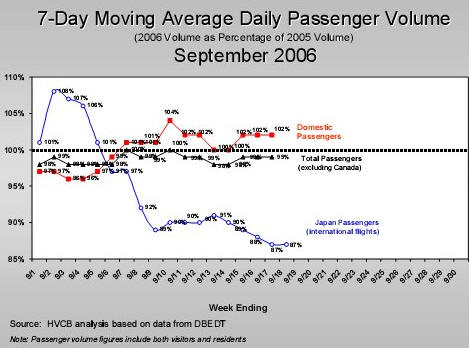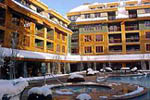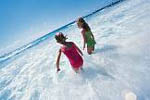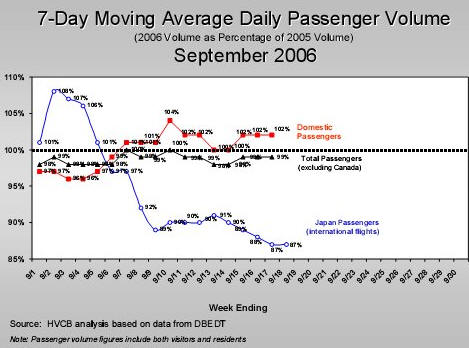New News
|
1. FEATURE
|
-
Domestic
Passenger Volume
on Par with
Prior-Year
Levels for the
Seven-Day Period
|
| |
2. HAWAI‘I
|
|
Current Industry
Developments |
-
Domestic Air
Seat Capacity
Projected to
Increase Ten
Percent Between
August and
October
|
-
Jetstar Approved
by DOT to Market
New
Honolulu-Australia
Routes
|
-
Hawaiian and
Harmony Announce
New Codeshare
Agreement
|
3. NATIONAL /
INTERNATIONAL
|
|
Consumer Travel
Behaviors |
-
One-Third of
American
Families Scale
Back Summer
Vacation Plans
Due to Higher
Gas Prices
|
-
Survey: Japanese
Travelers Look
for “Cheap,
Near, Short”
Vacations this
Summer
|
|
Current Industry
Developments |
-
ARC:Domestic and
International
Airfares
Increase in July
|
-
U.S. Airlines
Plan To Increase
Seat Capacity
This Year
|
Domestic Passenger Volume on Par
with Prior-Year Levels for the
Seven-Day Period
Despite increased airport
security measures nationwide
following the alleged terrorist
plot involving U.S.-bound
airplanes from the U.K., Hawai‘i
domestic passenger volume on
nonstop flights to the Islands
ended the latest seven-day
period (August 20, 2006) on par
with prior-year levels,
according to statistics
published by the state
Department of Business, Economic
Development and Tourism.
-
Domestic passenger volume
had been declining since
early August versus prior
year levels.
-
Domestic performance for the
latest seven day period is
especially noteworthy,
considering that August 2005
figures were some 10.4
percent higher than August
2004 passenger arrivals.
-
Total domestic passenger
volume to Hawai‘i (which
also includes returning
residents to Hawai‘i) is
currently down 1.5 percent
for the month (through
August 20th),
though the count is still on
pace to reach a record this
summer.
-
Nonstop passenger volume
from Japan was nine points
below prior-year levels for
the seven-day period, but
not inconsistent with past
month’s trends.Japanese
passenger volume is
currently down 4.8 percent
for the month of August
(results through August 21).
-
Total domestic and
international (excluding
Canada) passenger volume was
two points below prior-year
levels for the week.Through
August 20, total passenger
volume is 1.9 percent below
prior-year levels for
August.


CURRENT INDUSTRY DEVELOPMENTS
Domestic Air Seat Capacity
Projected to Increase Ten
Percent Between August and
October
Domestic air seats are projected
to increase 10.3 percent, while
international air seats are
forecasted to decline 3.2
percent during the three-month
rolling period between August
and October, compared to the
same period last year, according
to the
Department of Business, Economic
Development, and Tourism
(DBEDT) analysis of OAG flight
schedules:
Scheduled non-stop air seats to
Hawai‘i from the U.S. West are
projected to reach 1.6 million
between August and October, up
15.6 percent over prior-year
levels.Hawai‘i’s top domestic
market, Los Angeles, is expected
to see a 3.9 percent increase in
seats during the three-month
period.However, Hawai‘i’s second
largest market, San Francisco,
is projected to experience
double-digit declines in air
seats (-10.7%).Gateways with the
highest percentage increases
over prior-year levels include:
San Jose (+181.0%); Oakland
(+152.6%); and Phoenix
(+125.4%).
Scheduled air seats from the
U.S. East are projected to
decrease 11.9 percent between
August and October.Significant
drops are expected to be seen in
Cincinnati (-35.1%) and
Minneapolis (-20.0%), the MMA’s
seventh and fifth largest
gateways, respectively.The U.S.
East’s largest gateway, Chicago
will also experience a
double-digit decrease (-18.2%),
while the second largest
gateway, Dallas, will see a 3.3
percent boost in air seat
capacity for the period.

Jetstar Approved by DOT to
Market New Honolulu-Australia
Routes
Qantas subsidiary and budget
airline,
Jetstar,
has recently received U.S.
regulatory permission to
commence marketing its future
international long-haul services
between Australia (Sydney and
Melbourne) to Honolulu.Jetstar
hopes to operate five weekly
flights to Honolulu (three from
Sydney and two from Melbourne)
beginning in late November,
pending all regulatory
approvals.An official commercial
launch date to pre-sell and
market the new Honolulu service
has not yet been confirmed.
Hawaiian and Harmony Announce
New Codeshare Agreement
Hawaiian Airlines
and Canadian airline, Harmony
Airways, jointly announced a
code share agreement and
interline electronic ticketing
system.The agreement will allow
the airlines’ mutual customers
to make seamless flight
connections between the two
carriers, as well as allow
consumers to purchase single e-tickets.Harmony’s
Canadian consumers, for example,
will be able to make interisland
connections once arriving in
Honolulu.The code share
effectively expands Harmony’s
route system to Hawai‘i, and
allows the company to book
flights on Hawaiian Airlines in
its worldwide computer
reservations system.
|
3. NATIONAL /
INTERNATIONAL |
CONSUMER TRAVEL BEHAVIORS
One-Third of American Families
Scale Back Summer Vacation Plans
Due to Higher Gas Prices
A
recent survey of 5,000 U.S.
households, conducted by TNS for
The
Conference Board,
reveals that one in three
respondents (33%) have
significantly changed their
summer travel plans due to
higher gas prices.Of those
changing their plans, 74 percent
will be driving less; 63 percent
will be staying closer to home;
26 percent will postpone their
vacation; 26 percent will
shorten their vacations; and 25
percent will cancel their
vacation plans altogether due to
the rise in gas prices (multiple
responses allowed).The
Conference Board notes that the
survey was conducted before the
alleged terrorist plot against
flights between the U.K. and
U.S., and states that Americans’
summer travel plans may be
further impacted by the recent
threat.
Survey: Japanese Travelers Look
for “Cheap, Near, Short”
Vacations this Summer
According to a “Long Holiday
Travel” survey conducted by
Tokyo-based goo Research,
an increasing number of Japanese
consumers are planning their
summer travel around three main
criteria: 1. Cheap (tour
prices); 2. Nearby (destination
selection); and 3. Short
(duration of travel), reported
Travel Journal International.Of
the over 2,000 Internet
respondents, 70.0 percent stated
that they wanted to travel this
summer season, of which 78.5%
have selected domestic Japanese
destinations.The survey also
notes a rise in vacations of
“three days or less,” and “four
to six days,” due mainly to a
slight decrease in the average
number of travel days this year
compared to 2005.Survey results
also suggest that consumers’
travel budgets have also dropped
compared to last year.
-
The share of Japanese
travelers visiting Hawai‘i,
Saipan and Guam has fallen
to 2.7% this year (from 3.4%
in 2005), according to the
survey
-
Other top destinations,
aside from domestic Japan,
by share are as follows:
-
Asia, 9.5%
-
Europe, 4.6%
-
U.S. Mainland, Canada
2.8%
-
Hawai‘i, Saipan, Guam,
2.7%
-
Australia, New Zealand,
0.9%
CURRENT INDUSTRY DEVELOPMENTS
ARC:Domestic and
International Airfares Increase
in July
The Airlines Reporting
Corporation (ARC) released its
July 2006 operating statistics,
showing that sales totaled $5.8
billion, up eight percent over
July 2005.Total airfares
increased in July compared to
the same month last year with a
strong growth in both domestic
fares (+9.0%) and international
fares (+7.0%).E-ticketing
transactions were significant in
July, with 95.6 percent of all
ARC transactions being paperless
during the month.Results
represent ARC’s processing and
settlement of travel agency and
CTD sales transactions on behalf
of 147 airlines and railroads.
U.S.
Airlines Plan To Increase Seat
Capacity This Year
For the first time since summer
2005, U.S. airlines are
scheduled to increase domestic
seat capacity on a
year-over-year basis, according
to a
USA
Today
report.Passengers should expect
to see a two percent increase in
domestic seat offerings in
November 2006 compared with
November 2005, and a three
percent increase in December
2006 compared to the same month
last year.The report suggests
that the increase in seat
capacity reflects the airline
industry’s optimism for future
profits and may lead to lower
airfares.
Mahalo! |











